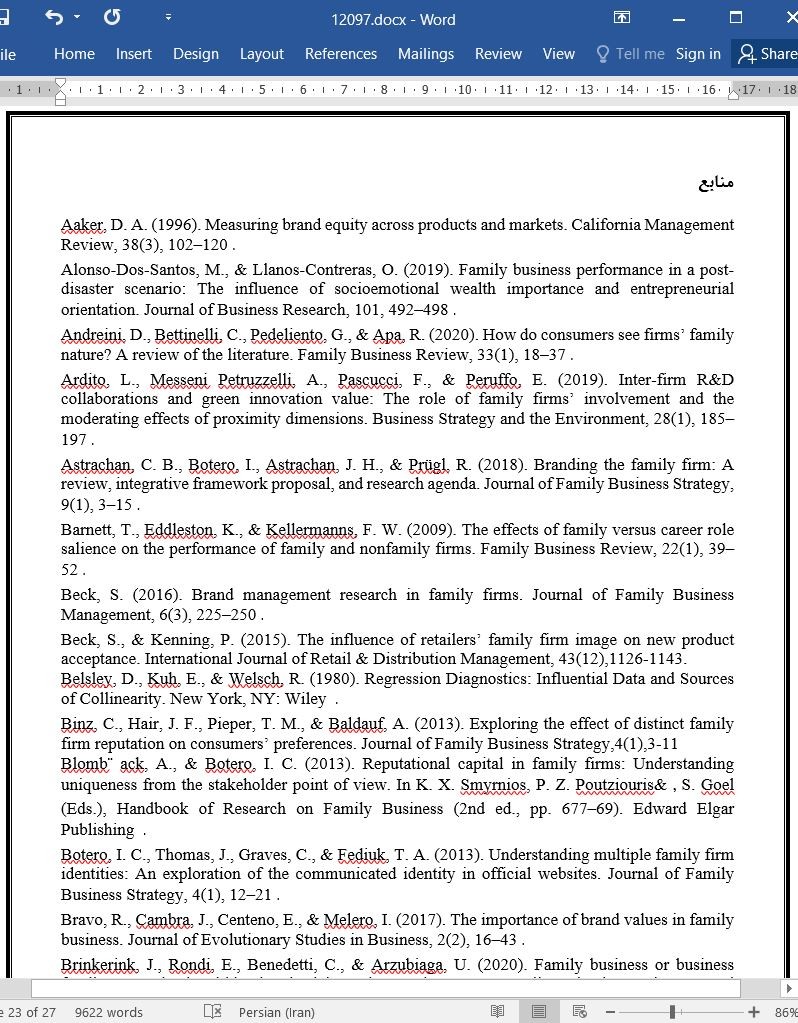
اهمیت برندهای شرکت خانوادگی و نقش اقتضایی هویت شرکت -خانواده
چکیده
این مطالعه به بررسی نقش مخاطبان خارجی در تعیین اهمیت برندهای شرکت خانوادگی و رابطه با عملکرد شرکت میپردازد. بر اساس تکنیک های متن کاوی و تحلیل شبکه اجتماعی و در نظر گرفتن ابعاد نفوذ برند، تنوع و ارتباط، از امتیاز برند معناشناختی استفاده میکنیم تا اهمیت رسانه اجتماعی را با توجه به برندهای شرکت خانوادگی بررسی کنیم. تحلیل نمونهای از 52.555 مقاله خبری که در سال ۲۰۱۷ درباره خانواده های کارآفرینی ایتالیایی منتشر شد، نشان داد که اهمیت برند با درآمد شرکت خانوادگی ارتباط دارد و این ارتباط زمانی قوی تر است که هویت بین خانواده و شرکت تطابق داشته باشد. این مطالعه ادبیات موجود را با ارائه یک چشم انداز غنی و چند جانبه درباره اینکه چگونه ادراک مخاطبان خارجی از برند، عملکرد شرکت خانوادگی را شکل می دهد، گسترش میدهد.
1. مقدمه
بررسی استراتژی های برندسازی شرکت خانوادگی برای درک این موضوع که چگونه آنها در اشتراک دو سیستم نامتعارف، خانواده و کسب و کار ارتباط برقرار می کنند، حائز اهمیت است. تحقیقی که به بررسی برندهای شرکت خانوادگی می پردازد عمدتاً از چشم انداز داخلی استفاده کرده است، به بررسی این موضوع پرداخته است که چگونه شرکتهای خانوادگی به طور استراتژیکی برندهای خود را مدیریت می کنند(بوترو، توماس، گریوز، و فدیوک، 2013؛ مسیلاتا و رینارد، 2011) و چگونه تصمیمات استراتژیک بر اهمیت برند تأثیر میگذارد(آردیتو، مسینی پترازلی، پاساچی، و پرافو، 2019؛ ماگیسترتی، دل ارا، فراتینی و مسینی پترازلی، 2020؛ مازلی، دی ماسیس، مسینی پترازلی، دل گیدایس، و خان، 2020). این مطالعات نشان میدهند که استراتژی های برند سازی که ماهیت خانوادگی شرکت را نشان می دهد ارتباط مثبت با عملکرد شرکت دارد(زالوگر، کلرمانز، ادلستون و ممیلی، 2012) و اینکه در نظر گرفتن خانواده "به عنوان یک برند شرکتی" منجر به رشد فروش بالاتر می شود. با این وجود، مسائل مدیریت برند نه تنها تا حدودی انتقال دهنده یا نشان دهنده نشانه های ارتباطی مربوط به برند است بلکه تا حدودی دریافت کننده و پردازش کننده اطلاعات است(براون، داسین، پرات و وتن، 2006؛ شانون، 1984). بنابراین، استفاده از چشم انداز خارجی برندهای شرکت خانوادگی و اهمیت اینکه ذینفعان خارجی منتسب به آنها برای افزایش درک ما از که چگونه این ذینفعان میتوانند بر انتخاب های مصرف کننده تاثیر بگذارند که منجر به مزیت رقابتی شرکت میشود، اهمیت دارد.
Abstract
This study explores the role of external audiences in determining the importance of family firm brands and the relationship with firm performance. Drawing on text mining and social network analysis techniques, and considering the brand prevalence, diversity, and connectivity dimensions, we use the semantic brand score to measure the importance the media give to family firm brands. The analysis of a sample of 52,555 news articles published in 2017 about 63 Italian entrepreneurial families reveals that brand importance is positively associated with family firm revenues, and this relationship is stronger when there is identity match between the family and the firm. This study advances current literature by offering a rich and multifaceted perspective on how external audiences perceptions of the brand shape family firm performance.
1. Introduction
Studying the branding strategies of family firms is critical to understand how they communicate at the intersection of two idiosyncratic systems, the family and the business. Research studying family firm brands has mainly adopted an internal perspective, exploring how family firms strategically manage their brands (Botero, Thomas, Graves, & Fediuk, 2013; Micelotta & Raynard, 2011), and how strategic decisions influence brand relevance (Ardito, Messeni Petruzzelli, Pascucci, & Peruffo, 2019; Magistretti, Dell’Era, Frattini, & Messeni Petruzzelli, 2020; Mazzelli, De Massis, Messeni Petruzzelli, Del Giudice, & Khan, 2020). These studies show that branding strategies that communicate the family nature of the firm positively relate to firm performance (Zellweger, Kellermanns, Eddleston, & Memili, 2012), and that viewing the family “as a corporate brand” leads to higher sales growth. However, brand management concerns not only the party communicating or transmitting the informational cues pertaining to the brand but also the party receiving and processing such information (Brown, Dacin, Pratt, & Whetten, 2006; Shannon, 1948). Therefore, adopting an external perspective of family firm brands and the importance that external stakeholders attribute to them is crucial to advance our understanding of how these stakeholders can affect consumer choices that lead to the firm’s competitive advantage.
چکیده
1. مقدمه
2. پیشینه نظری و فرضیه ها
2.1. اهمیت برند در تلاقی خانواده و سیستم های کسب و کار
2.2. هویت شرکت خانوادگی
3. روش شناسی تحقیق
3.1. جمع آوری داده ها
3.2. متغیرهای مطالعه
4. نتایج
5. بحث و نتیجه گیری
منابع
Abstract
1. Introduction
2. Theoretical background and hypotheses
2.1. Brand importance at the intersection of the family and business systems
2.2. Family-firm identity
3. Research methodology
3.1. Data collection
3.2. Study variables
4. Results
5. Discussion and conclusions
Acknowledgements
References
- اصل مقاله انگلیسی با فرمت ورد (word) با قابلیت ویرایش
- ترجمه فارسی مقاله با فرمت ورد (word) با قابلیت ویرایش، بدون آرم سایت ای ترجمه
- ترجمه فارسی مقاله با فرمت pdf، بدون آرم سایت ای ترجمه



